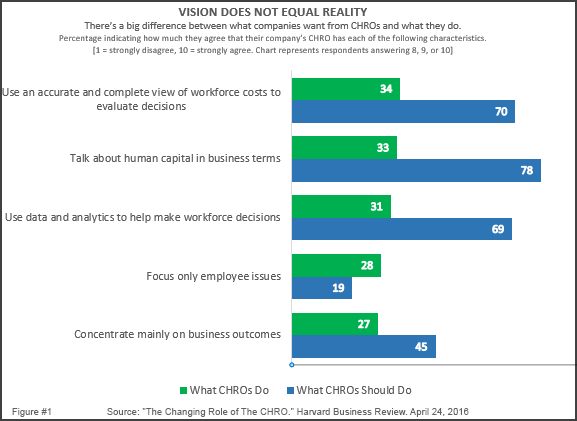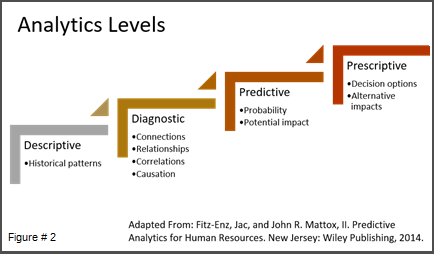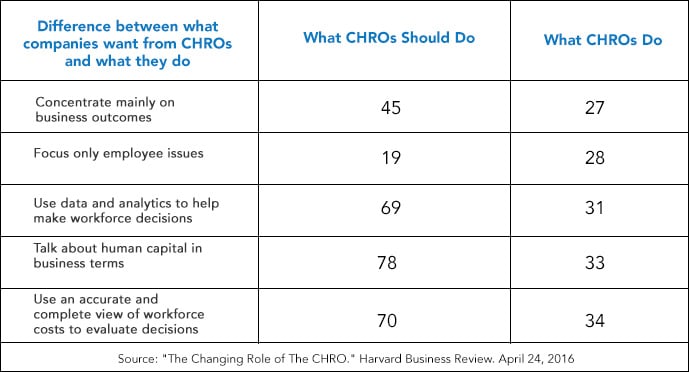
We have measured data in HR for decades, but, to be blunt, much of it has been navel-gazing. We measure how well we are doing what we do, but don’t spend enough analytical energy on what HR should do to help the business.
Efficiency and effectiveness measures are helpful, but they will not set your CEO on fire. All the buzz about “aligning to the business” has done little but point out the difference between what CEOs want from HR and what HR does (Figure 1).

The Future is Now
Talent analytics will change the way HR does business, and soon. The scarcity of talent, competitive pressures, and the need to align people to the business are driving expectations for CHROs to make better decisions based on data. Investment in analytics is the next move for HR, and it will change the way their companies manage people.
Four trends changed what is possible in people analytics.
- Availability of data. The amount of data available for analysis is increasing exponentially. Enterprise systems have become better integrated, and data mining tools are ubiquitous.
- System capabilities. When we were implementing HRIS applications twenty years ago, getting reports was the last consideration. Today, we regard user-friendly reporting and analytics as essential services. Vendors who don’t provide robust analytics will fall behind.
- Cost. Analytical tools have been scarce and beyond the reach of all but the largest budget, but tools for business users are becoming commonplace. Marketing has driven most of the progress, but now the techniques are migrating to people analytics.
- Expertise. HR has not typically had much capability in analytics, but with better tools and more trained data analysts available, CHROs find it easier to re-staff and upskill HR.
Start from Where You Are
Most of the people we work with are not ready for advanced analytics -- they are just getting better at reporting. You can gauge where you are by comparing what you do now to our modification of Jac Fitz-Enz’s levels of analytics (Figure 2).

There is no need to jump into advanced analytics today to create impact. Use the tools you have today. Making the move now will lay the groundwork to grow your capability, and in what may seem like no time, you will answer questions like these:
- What drives performance in the organization?
- Which top performers will make good managers and which will not?
- How much is our mentorship program worth?
- Which employees should be on the fast track to executive leadership?
- What is the optimum development path for each employee?
- What is the financial impact of each our development programs?
Form a Team
When we speak of creating an analytics team, you may think of data experts, analysts, and functional experts. They are important -- but first, you need a powerful executive team. Ally yourself with Marketing and Finance. Not only do they have analytical experience, they control a lot of resources.
Marketing has been using predictive analytics for twenty years or more. Effective marketers refined their analytics to where they can provide an individual experience to people in an audience of millions. It creates possibilities for adaptation to the employee experience that were not possible just a few years ago. The techniques they use in managing the customer life cycle will help form the basis for managing the employee life cycle. If anyone knows how to use analytics to predict human behavior, Marketing does.
Your CFO has been predictive analytics for decades to optimize the ROI of capital investments, but until recently CFOs had difficulty quantifying human capital. They viewed people only as an expense. That perception is transforming, and now, Finance executives want to quantify both the cost and contribution of the workforce.
If your CFO doesn’t think way yet, try a simple statement of value. What creates value in an organization is how people interact with machines, processes, information, and each other. So, without people, the only value capital assets have is their resale value. Through analytics, we can measure the value of human capital, and we can influence its contribution.[1]
Before you begin these conversations, we recommend a little reading. Making Human Capital Analytics Work: Measuring the ROI of Human Capital Processes by Jack and Patricia Putnam Phillips, written for business people, will give you a solid grounding. The authors worked with Jac Fitz-Enz, whom we know as the father of HR metrics.
9 Steps to Better Results
Once your executive team in on board, the next steps are straightforward:
- Attack a business problem. Don’t waste time on fuzzy measures and trendy interventions, and don’t worry about “alignment to the business.” If your organization needs to lower attrition for machinists, and you help do that, you are aligned. One of our clients had a great first effort when they improved new hire retention by giving new employees the responsibility and accountability for tracking their own training progress.
- Analyze what people do to solve the problem and how what they do meets the business need.
- Conduct research into how employee behavior affects the outcome. Learn what factors affect their behavior.
- Create a hypothesis: Based on what you learned, what will happen if you do X? What will happen if you do nothing?
- Test the hypothesis. A good way to do this is with a small pilot group, using other groups as controls.
- Analyze the results. You can use process measures, such as efficiency and effectiveness, but the real prize is the business outcome that improves your CFO’s balance sheet or income statement.
- Communicate the result. Tell your CXOs the story with financial results as the keynote.
- Fine-tune your process and tackle the next problem.
- Continue to build your analytics capability.
One last bit of advice: stop trying to prove HR’s value to the business. Instead, increase the value of the business. Two things of which we are sure: first, once you do, you will be asked to repeat; second, you will find resources easier to obtain.
References :
a) [1] Phillips, Jack and Patricia Pulliam Phillips. Making Human Capital Analytics Work: Measuring the ROI of Human Capital Processes. McGraw-Hill Education. 2015
b) Survey Study :

Pixentia is a full-service technology company dedicated to helping clients solve business problems, improve the capability of their people, and achieve better results.


